Complete Solutions to BIO of chapter ECOSYSTEM of Class 12 book with complete answers and questions
| Class 12 | BIOLOGY |
| Chapter | ECOSYSTEM |
| NCERT FINGERTIPS | BIO |
| Number Of Questions | 100 |
| Academic Year | 2023-24 |
Which one of the following is not correct match of the term and its description?
02:46View SolutionMatch column I with column II and choose the correct option from the given codes.
 03:33View Solution
03:33View SolutionTerm 'ecosystem' was coined by
02:45View SolutionWhich of the following pairs is not correct?
02:32View SolutionVertical distribution of different species occupying different levels in dense vegetation is called
03:29View SolutionWhich of the following aspects is not a component of functional unit of ecosystem?
03:02View SolutionIn a comparative study of grassland ecosystem and pond ecosystem, it may be observed that
04:00View SolutionThe movement of energy from lower to higher trophic level is
03:10View SolutionThe given pie diagram represents different components of the soil. Identify P,Q and R and select the correct option
 02:50View Solution
02:50View SolutionThe rate of conversion of light energy into chemical energy of organic molecules in an ecosystem is
03:30View SolutionRead the given statements and select the correct option.
Statement 1: Net primary productivity is less than the gross primary productivity.
Statement 2 : Net primary productivity is equal to the gross primary productivity minus the respiration losses.02:58View SolutionThe biomass available for consumption by the herbivores and the decomposers is called
04:48View Solution____ is the rate of production of organic matter by consumers.
05:03View SolutionThe rate of formation of new organic matter by rabbit in a grassland, is called.
06:31View SolutionPrimary productivity depends upon
02:53View SolutionThe annual net primary productivity of the whole biosphere is approximately
02:45View SolutionWhich one of the following exhibits least productivity?
02:56View SolutionWhich one of the following is the most productive ecosystem?
02:36View SolutionArrange the following ecosystems in increasing order of their mean NPP .
(A) Tropical deciduous forest
(B) Temperate coniferous forest
(C ) Tropical rainforest
(D) Temperate deciduous forest02:57View SolutionFragmentation, leaching and catabolism are some of the important steps of decomposition. Study the following statements I , ii and iii regarding these and select the correct option.
(i) Detritivores (e.g., earthworm) breakdown detritus into smaller particles.
(ii) Water soluble inorganic nutrients go down into soil horizon and get precipitated as unavailable salts.
(iii) Decomposers (e.g., bacteria and fungi) secrete digestive enzymes and degrade detritus into simpler inorganic substances.03:01View SolutionRead the given statements and select the correct option. Statement 1 : Decomposition is the physical and chemical breakdown of complex organic matter into simple inorganic substances.
Statements 2: Humification is the process of formation of humus from detritus or organic remains.03:02View Solutionwhich of the following is not characteristic of humus?
06:17View SolutionMatch column I with column II and select the correct option from the given codes.
`{:("column I","Column II"),("Gross primary productivity",(i)"Self-sustainable"),("Net primary productivity",(ii)"Aquatic ecosystem"),("Pond",(iii)O_(2)"requiring process"),("Aquarium",(iv)"Photosynthetic production"),("Decompositon",(v)"Available to secondary consumers"):}`04:11View SolutionDuring the process of decompositon
02:51View SolutionRate of decompositon depends upon
03:12View SolutionDecomposers are also called as
02:07View SolutionThe ultimate energy source of all ecosystem is
03:51View SolutionPercentage of photosynthetically active radiation (PAR) in the incident solar radiation is
04:10View SolutionPercentage of photosyntetically active radiation (PAR) that is captured by plants in synthesis of organic matter is
03:27View SolutionRead the given statements and select the correct option.
Statement 1: Herbivours are also called as first order consumers.
Statement 2: Herbivores obtain their food directly from plants.03:06View SolutionGiven figure represents two food chains (X and Y) linked together to form a food web.

Identify the types of food cahin X and Y and the organism A that interconnects these food cahins.03:03View SolutionSelect the option that correctly identifies A,B and C in the table.
 04:17View Solution
04:17View SolutionSelect the incorrect food chain
04:14View Solution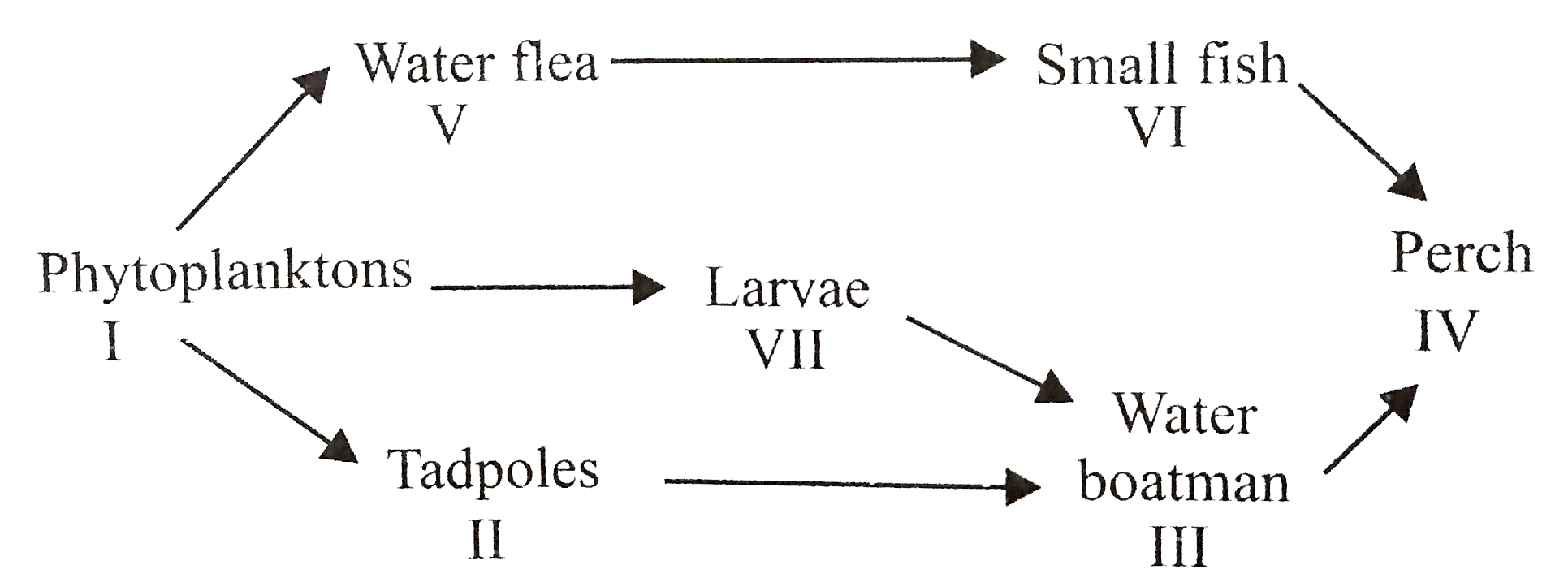
Which of the following organisms in the given food web act both as apredator and a prey?05:21View Solution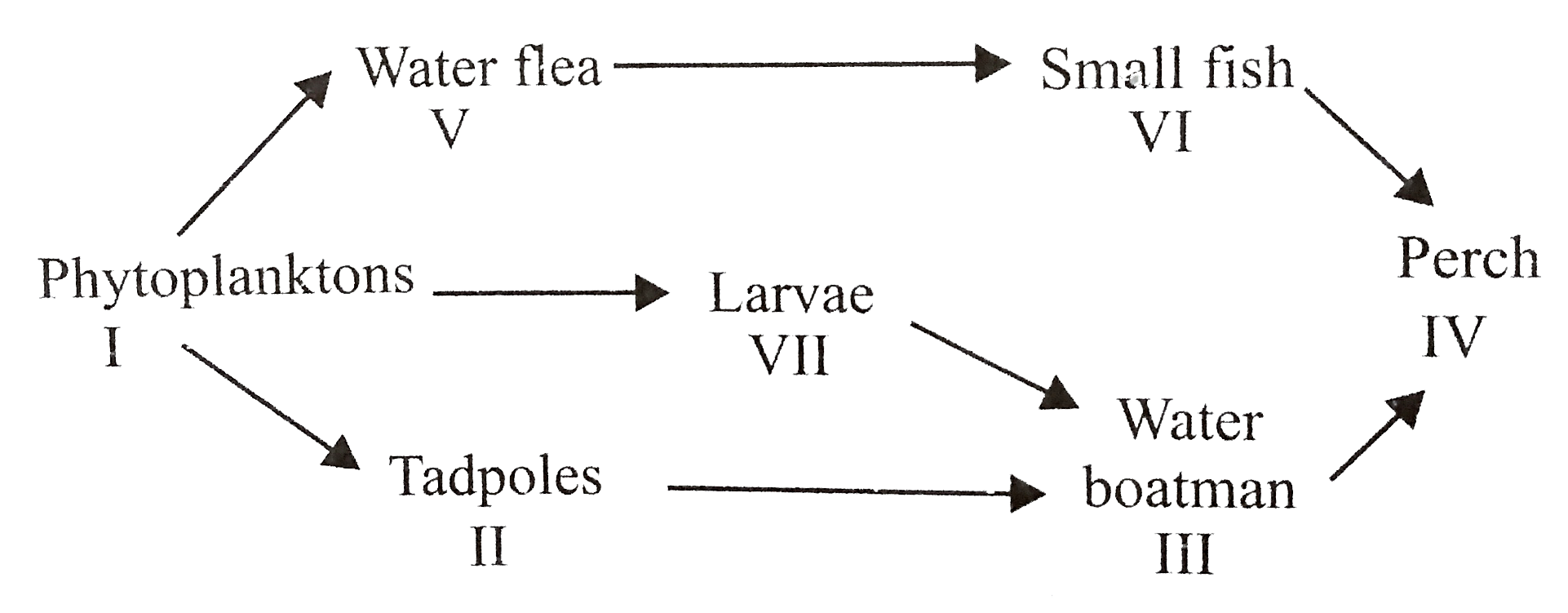
Which of the following organisms in the given food web act as a secondary consumers?02:16View SolutionGiven food web contains some missing organisms, 1,2,3 and 4. Identify these organisms and select the correct answer?
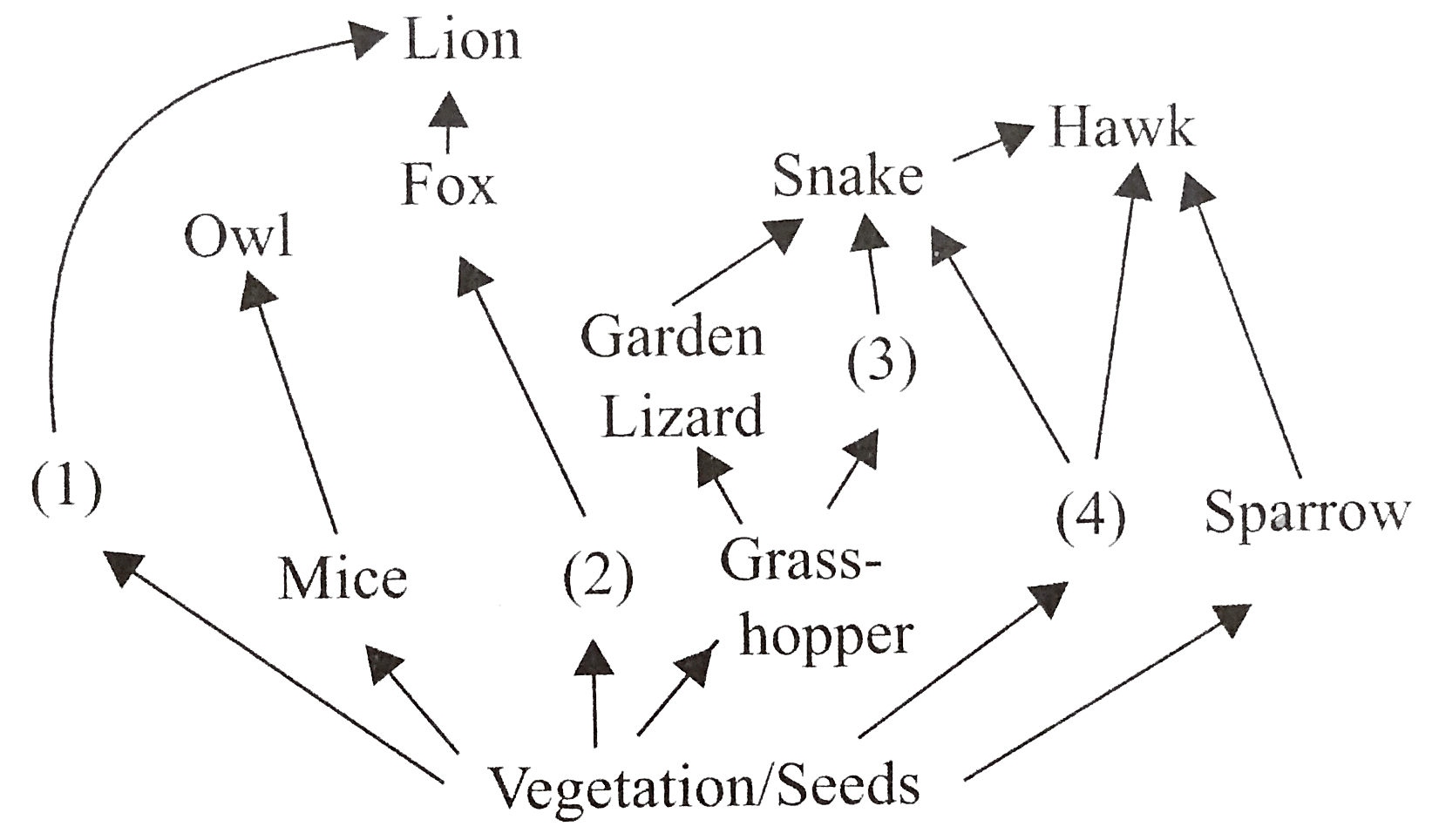 04:09View Solution
04:09View SolutionMathc column I with column II and select the correct option from the given codes.
`{:("column I","column II"),("Gross primary productivity",(i)"Geen plants"),("Secondary productivity",(ii)"Rate of synthesis of organic matter by consumers"),("Transducers",(iii)"Total organic matter produced from solar energy"),("Food web",(iv)"Interconnection of food chains"):}05:53View SolutionIn the given food web, and increase in the population of hawks will not result in
 05:28View Solution
05:28View SolutionIn an aquatic ecosystem, the organism present at the trophic level equivalent to cows in grasslands is
04:18View SolutionProductivity at the second trophic level is always.
04:13View SolutionIf 10 joules of energy is available at the producer level, then amount of energy present at the level of secondary consumer is
04:25View SolutionStudy the following statements regarding food chains and select the correct ones.
(i) Removal of 80% tigers from an area resulted in greatly increased growth of vegetation.
(ii) Removal of most of the carnivores resulted in an increased population of deers.
(iii) The lenght of food chains is generally limited to 3-4 trophic levels due to energy loss.
(iv) The lenght of food chains may vary from 2 to 8 trophic levels.
A) i and ii B) ii and iii C) i and iii D) iii and iv04:34View SolutionThe energy and biomass relationship between the organisms at different trophic levels can better expressed by
02:43View SolutionGiven figure represents a pyramid of biomass in an aquatic ecosystem.

Identify A and B and select the correct answer.
(i) A is the crop which supporsts and B is the crop which is supported.
(ii) A is the crop which is supported and B is the crop which supports.
(iii) A is phytoplanktons and B is zooplanktons.
(iv) A is zooplanktons and B is phytoplanktons.05:11View SolutionWhich kind of pyramid is represented by the given figure?
 04:11View Solution
04:11View SolutionIn an open ocean, the biomass of primary producers (microscopic algae) is often lower than the biomass of higher trophic levels (zooplanktons and fish), as illustrated below by an inverted pyramid of biomass. How can there be enough food in an open ocean to support the higher trophic levels?
 04:40View Solution
04:40View SolutionStudy the following ecological pyramids carefully.
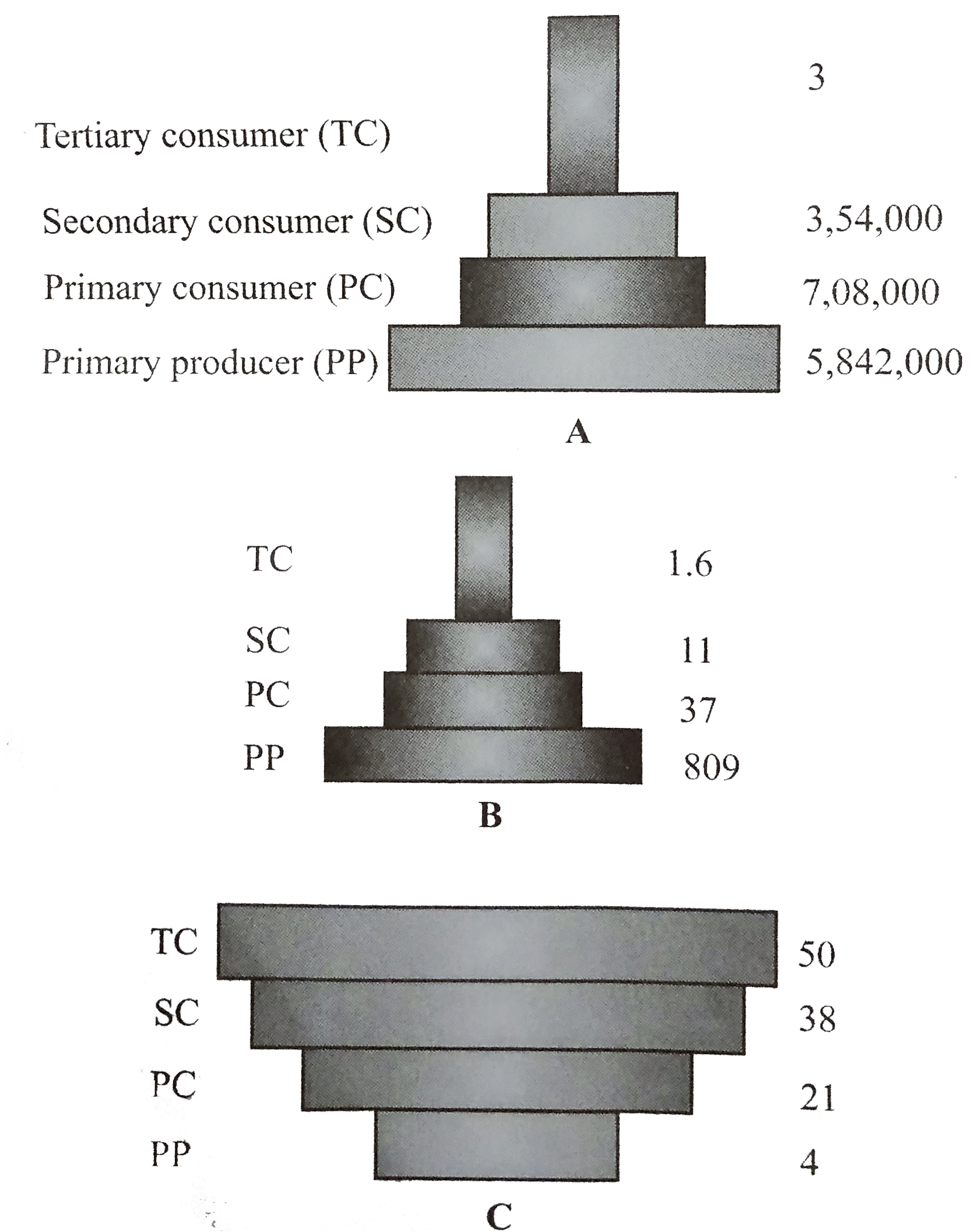
Mathc the following statements I,ii and iii with gien pyramidsa, B and C and select the correct answer.
(i) Inverted pyramid of biomass depicting small standing crop of phytoplanktons supporintg a large standing crop of zooplanktons
(ii) Pyramid of numbers in a grassland ecosytems showing about 6 milion producers.
(iii) Upright pyramid of biomass05:14View SolutionRead the following statements and select the correct ones.
(i) A given species may occupy more than one trophic level in the same ecosystem at the same time.
(ii) Productivity of an aquatic ecosystem is less than that of a terrestrial ecosystem.
(iii) Producers constitute the first trophic level of a detritus food chain.
A) i and ii
B) ii and iii
C) i and iii
D) i, ii and iii05:16View SolutionWhich one of the following animals may occupy more than one trophic levels in the same ecosystem at the same time?
03:00View SolutionOrganisms which are associated with first as well as third trophic level are
03:38View SolutionWhich of the following representations shows the pyramid of numbers in a forest ecosystem?
03:41View SolutionPyramid of biomass for a grazing food chain represents
05:03View SolutionMr. X is eating curd/yoghut. For this food intake in a food chain he should be considered as occupying
03:22View SolutionWhat kind of pyramid is represented by the given figure?
 02:42View Solution
02:42View SolutionWhich kind of pyramid is represented by the given figure?
 03:47View Solution
03:47View SolutionIn a grassland ecosystem, if the number of primary producers (plants) is approximately 6 million, the number of top carnivors. Which may be supported by them will be
01:26View SolutionThe given pyramid best represents
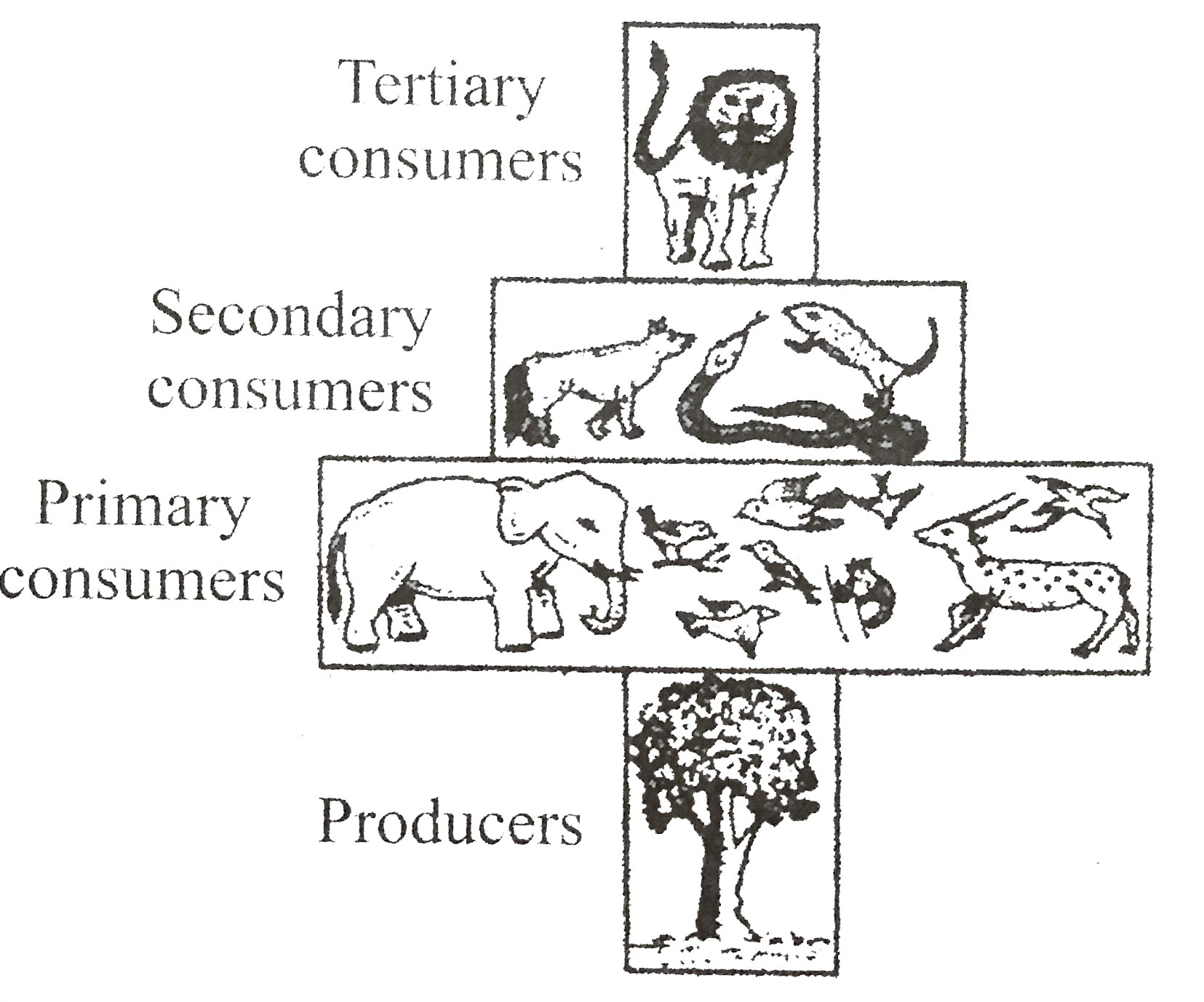 02:18View Solution
02:18View SolutionRead the statements and select the correct option Statement 1: In an aquatic ecosystem, pyramid of biomass is inverted.
Statement 2: Biomass depends upon reproductive potential and longevity of individuals.02:21View SolutionStudy the following statements and select the incorrect one.
04:11View SolutionStudy the following statements and select the incorrect ones.
(i) Pyramids of energy and yearly biomass production can never be inverted, since this would violate the laws of thermodynamics.
(ii) Pyramids of standing crop and numbers can be inverted, since the number of organisms at a time does not indicate the amount of energy flowing through the system.
(iii) There are certain limitations of ecological pyramids such as they do not take into account the same species belonging to two or more trophic levels.
(iv) Saprohytes are not given any place in ecological pyramids even though they play a vital role in the ecosystem.05:50View SolutionThe stable community during an ecological succession that would be near equilibrium with the environment is called
03:37View SolutionPrimary succession occurs on
03:56View SolutionSuccessions that occur on soils or areas which have recently lost their community are reffered to as
03:34View SolutionMatch column I with column II and select the correct option from the given codes.
`{:("column I","column II")
,`("Gross primary productivity",(i)"Geen plants"),("Secondary productivity",(ii)"Rate of synthesis of organic matter by consumers"),("Transduc`{:("column I","column II"),("Bacteria",(i)"Prisere"),("Green plants",(ii)"Transducers"),("Primary succession",(iii)"Lithosere"),("Succession on bare rock",(iv)"Micro-consumers"):}`03:46View SolutionWhich one of the following statements is correct for secondary succession?
04:28View SolutionThe rate of secondary succession is faster than primary succession because.
04:53View SolutionAs the succession proceeds number and types of ____ change.
03:31View SolutionWhich of the following is considered as pioneer community is xerarch?
03:23View SolutionCorrect sequence of stages of succession on a bare rock is:
1) Lichens → Mosses → Grasses → Shrubs → Trees
2) Trees → Shrubs → Lichens → Mosses → Grasses
3) Mosses → Shrubs → Trees → Lichens → Grasses
4) Mosses → Lichens → Grasses → Shrubs → Trees.02:55View SolutionIn lithosere, foliose lichens make the conditions favourable for the growth of
03:00View SolutionRead the given statements and select the correct option:
Statement 1: Pioneer community is the stable and final biotic community of an ecological succession.
Statement 2 : Pioneer community has maximum diversity and niche specialisation.02:52View SolutionCorrect sequence of stages of succession of a lithosere is:
1) Foliose lichens `rarr` Crustose lichens `rarr` Mosses `rarr` Annual grasses `rarr` Perennial grasses `rarr` Shrubs `rarr` Trees.
2) Crustose lichens `rarr` Foliose lichens `rarr` Mosses `rarr` Perennial grasses `rarr` Annual grasses `rarr` Annula grasses `rarr` Shrusb `rarr` Trees
3) Reed swamp stage `rarr` Sedges `rarr` Floating plants `rarr` Submerged plants
4) Sedges `rarr` Reed swamp stage `rarr` Floating plants `rarr` Submerged plants03:33View SolutionSelect the correct sequence of succession in a pond.
1) Submerged plants `rarr` Floating plants `rarr` Reed swamp stage `rarr` Sedges
2) Floating plants `rarr` Submerged plants `rarr` redd swamp stage `rarr` Sedges
3) Reed swamp stage `rarr` Sedges `rarr` Floating plants `rarr` Submerged plants
4) Sedges `rarr` Reed swamp stage `rarr` Floating plants `rarr` Submerged plants03:59View SolutionGiven below are some of the stages of the hydrarch.
(A) March-meadow stage
(B) Reed-swamp stage
(C ) submerged plant stage (D) Phyotplankton stage
Select the option that represents the correct sequence of these stages.04:07View SolutionMathc column I with column II and select the correct option from the given codes.
`{:("column I","Column II"),("Presence of 3-4 storeyed",(i)"Blue green angle"),("A biome having grasses with scattered trees",(ii)"Stratification"),("Man made ecosystem",(iii)"Savannah"),("Pioneer in hydrosere",(iv)"Dam"):}`04:06View SolutionIn the given figure A,B,C,D,E and F represent some stages of hydrosere, Select the correct statement regarding these.
 05:07View Solution
05:07View SolutionThe correct sequence of plants in a hydrosere is
03:28View SolutionThe second stage of hydrosere is occupied by plants like
04:25View SolutionAn ecosystem which can be easily damaged but can recover after some time if damaging effect stops, will ba having.
04:08View SolutionDuring the stages of succession in a given ecosystem, the following changes in characteristics may be observed.

Which one of the characteristics A,B,C,D or E is responsible for the apparent high degree of stability associated with a climax acosystem?04:18View SolutionAll type of successions leads to
04:55View SolutionMathc column I with column II and select the correct option from the given codes.
 05:10View Solution
05:10View SolutionMatch column I with column II and select the correct option from the given codes.
`{:("column I","Column II"),("Artermisla tridentata",(i)"Grows better in overgrazed area"),("Capparis spinosa",(ii)"Drominate in areas destructed by fires"),("Pleris aquilina and Pyronema",(iii)"Indicates intense soil erosion"),("Amaranthus and Chenopodium",(iv)"Saline soils"):}`05:17View SolutionSelect the pairs of sediamentary biogeochemical cycles.
I. Hydrogen cycle and water cycle
II. Phosphorus cycle and sulphur cycle
III. Calcium cycle and magnesium cycle
IV. Carbon cycle and nitrogen cycle03:45View SolutionWhich one of the following is not a gaseous biogeochemical cycle in ecosystem?
03:54View SolutionThe function of reservoir pool is to meet with the deficit of nutrient that occurs due to
04:12View SolutionMathc column I with column II and select the correct option from the given codes.
`{:("Column I","Column II"),("Standing state",(i)"Fast and nearly perfect"),("Gaseous cycles",(ii)"Amount of nutrients present in soil at given time"),("Standing crop",(iii)"Slow and less perfect"),("Sedimentary cycles",(iv)"Mass of living matter in a unit area"):}`05:07View SolutionStudy the given biogeochemical cycle and identify the steps I and ii
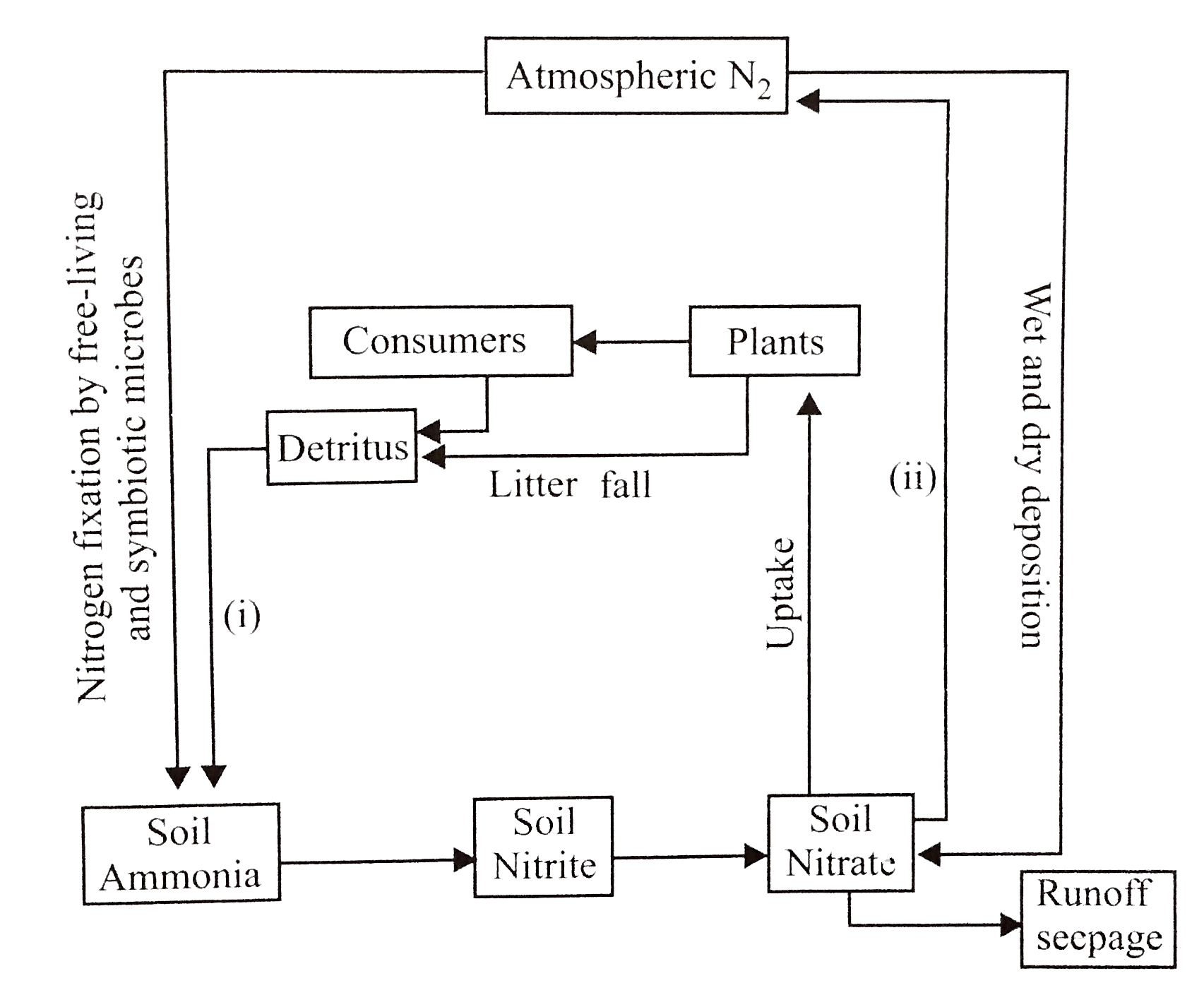 05:04View Solution
05:04View SolutionAbout `71%` of total global carbon is found is
02:08View SolutionWhat percentage of total global carbon is atomospheric carbon?
1) 0.0003
2) 0.01
3) 0.1
4) 0.301:35View SolutionWhich of the following processes does not contribute to the `CO_(2)` pool in the atmosphere?
1) Respiration by producers
2) Photosynthesis by producers
3) Respiration by consumers
4) Decomposition by decomposers.02:20View SolutionRead the given statements and select the correct option.
Statement 1: Major reservoirs of phosphorus are phosphate rocks and fossil bone deposits laid down in the past geological ages.
Statement 2: During weathring of rocks, minute amounts of these phosphates dissolve in soil solution and are absorbed by the roots of the plants.
A. Both statements 1 and 2 are correct.
B. Statement 1 is correct but statement 2 is incorrect.
C. Statement 1 is incorrect but statement 2 is correct.
D. Both statement 1 and 2 are incorrect.03:35View SolutionStudy the given flow chart and select the correct statement regarding this.
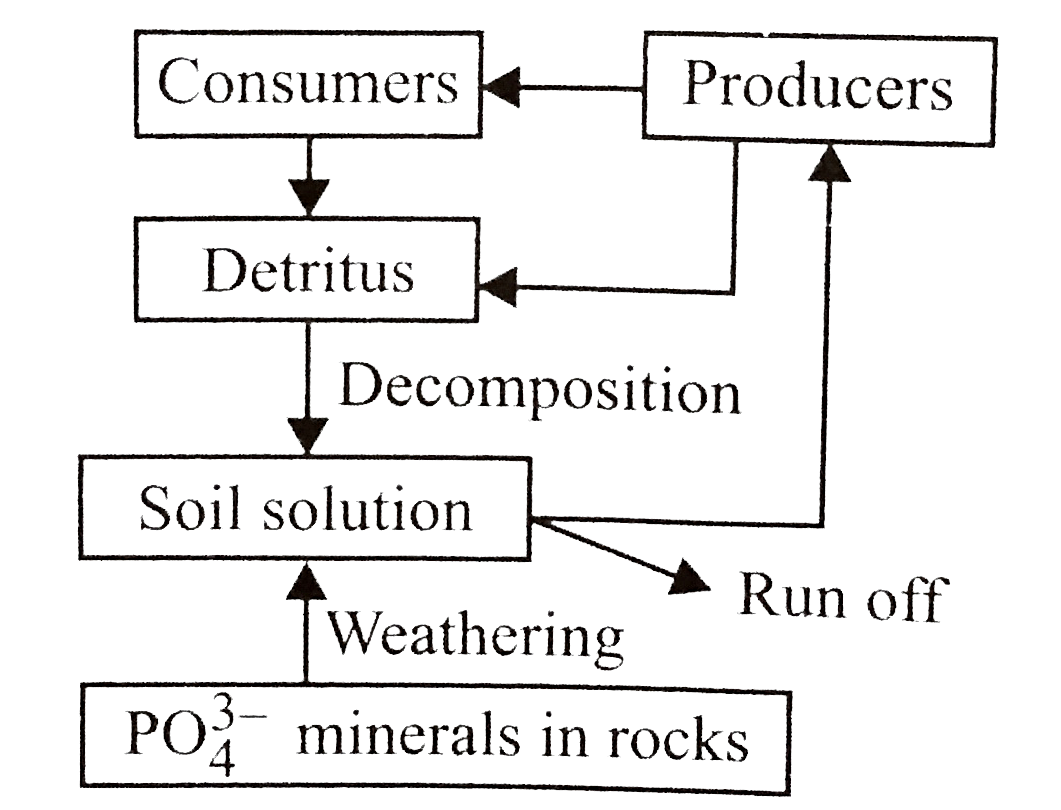
(i) It represents phosphorus cycling in a terrestrial ecosystem.
(ii) It represents phosphorus cycling in an aquatic ecosystem.
(iii) Natural resenvoir of phosphorus is phosphate rocks.
(iv) There is no repiratory release of phosphorus into atmosphere.
(v) Gaseous exchange of phosphorus between organisms and enviornment occurs to a considereable extent.04:04View SolutionMajor source of sulphur is
00:56View SolutionWhich one of the following is not one of the three aspects studied in biogeochemical cycling?
01:51View SolutionRead the given statement and select the correct option.
Statement 1: Global water cycle does not involver the living organisms.
Statement 2 : In global water cycle. Water circulates between hydrosphere and atmosphere.02:30View SolutionWhich of the following is most important in water cycle?
01:42View SolutionThe ecosystem services include
01:26View SolutionOut of the total proposed cost of various ecosystem services, cost of climate regulations and habitat for widilife are
01:20View SolutionWhat is the amount of average price tag on nature's life support services determined by Robert Constanza and his colegues?
01:07View Solution
BIO questions and complete solutions for chapter ECOSYSTEM of MTG BIOLOGY (ENGLISH) of Class 12
